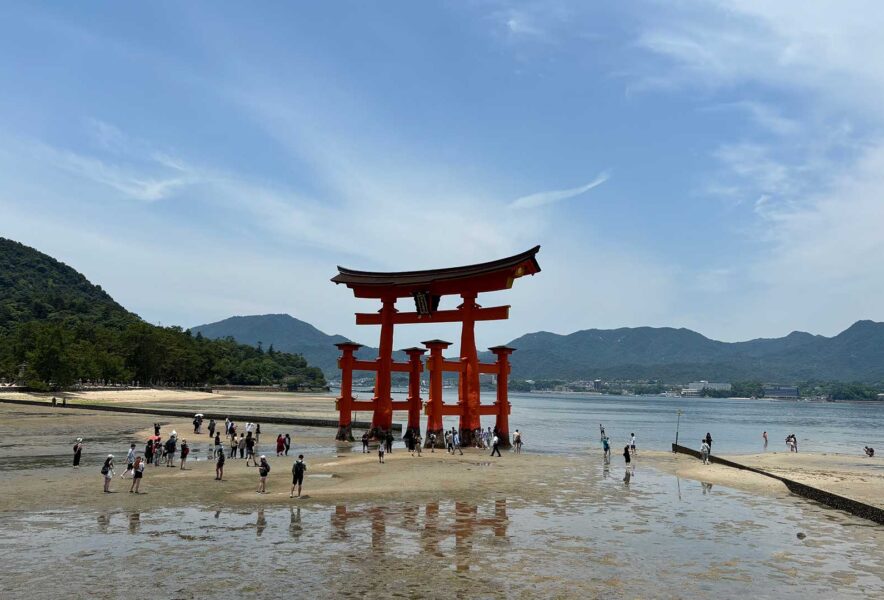Today, we will introduce a classic Hiroshima walk around two of Hiroshima’s World Heritage sites. First, take a ferry to Miyajima and enjoy the majestic beauty of Itsukushima Shrine. After that, stroll around the Atomic Bomb Dome and Hiroshima Peace Memorial Park with prayers for peace. Finally, learn about the tragedies of war and the importance of peace at the Hiroshima Peace Memorial Museum. From the Orizuru Tower, you can enjoy a spectacular view of the city, which will soothe your soul. Enjoy the charm of Hiroshima to the fullest.
- Hiroshima Stroll Today’s route
- Hiroshima Stroll Introduction
- Hiroshima Stroll Starts
- JR Hiroshima Station, the gateway to Hiroshima
- Miyajima-guchi Station, the starting point of Miyajima sightseeing
- Board the Miyajima Ferry
- Otorii Gate on the Seto Inland Sea
- Tour of Miyajima starting from Miyajima Pier
- Mysterious Itsukushima Shrine, whose expression changes with the hour
- Healing in the Autumn Foliage Tunnel at Momijidani Park
- Standing in a vast space with a sense of history at Senjo-kaku
- Enjoy local delicacies at Miyajima Omotesando Shopping Street
- Riding the tram
- The World Heritage Site Atomic Bomb Dome reminds us of the tragedy of the atomic bombing.
- Stroll through Peace Memorial Park and renew your wish for peace
- Enjoy the spectacular view at Hiroshima’s new landmark, Orizuru Tower
- From Ebisucho Station to Hiroshima Station
- Hiroshima Station
- Hiroshima Stroll |A review of the classic Hiroshima course for the first time visiting two World Heritage sites.
- Access to JR Hiroshima Station
Hiroshima Stroll Today’s route
A. Hiroshima Station (JR Sanyo Main Line)
B. Miyajimaguchi Station
C. Miyajimaguchi (Ferry)
D. Miyajima Pier
E. Itsukushima Jinja Shrine
F. Miyajima Omotesando Shopping Street
G. Miyajima Pier (Ferry)
H. Miyajimaguchi (Hiroshima Electric Railway)
I. Atomic Bomb Dome
J. Peace Memorial Park
K. Peace Memorial Museum
L. Orizuru Tower
N.Hiroshima Station
Hiroshima Stroll Introduction
About the Hiroshima Stroll Course
We propose a one-day walking tour of Itsukushima Shrine and the Atomic Bomb Dome, starting from Hiroshima Station. First, take a train from Hiroshima Station to Miyajima-guchi and take a ferry to Itsukushima Shrine. Next, return to Hiroshima City by tram and visit the Atomic Bomb Dome. We will show you in detail how to enjoy the attractions of Hiroshima to the fullest while using your time efficiently.
About World Heritage Sites in Hiroshima
Hiroshima is home to two World Heritage Sites: the Atomic Bomb Dome, a symbol of peace, and the beautifully landscaped Itsukushima Shrine. The Atomic Bomb Dome is a symbol of the damage caused by the atomic bomb dropped on August 6, 1945, and is visited by many people from around the world as a place to emphasize the importance of peace. The second is “Itsukushima Shrine,” featuring a large vermilion-lacquered torii gate floating in the sea. This shrine was built in the 12th century and symbolizes the fusion of Japan’s beautiful nature and architectural technology. Because of its unique beauty, Itsukushima Shrine continues to attract people from all over the world.

Located on the site where the atomic bomb was dropped during World War II, the park is visited by peace-loving people from all over the world. The park was established in 1949 and exists as a symbol to remember the horrors of war and to pledge the abolition of nuclear weapons and lasting peace.
The park is dotted with many memorial facilities, including the Atomic Bomb Dome, the Peace Bell, the Peace Lamp, and the Cenotaph for the Atomic Bomb Victims, which strongly emphasize to visitors the tragedy of war and the importance of peace. The Peace Memorial Ceremony, held every year on August 6, attracts a large number of people to mourn the victims and renew their pledge for peace.
Hiroshima Stroll Starts
JR Hiroshima Station, the gateway to Hiroshima
We start from Hiroshima Station. From the Shinkansen Hiroshima Station, take the Central Exit to the JR Conventional Lines. The platform for Miyajimaguchi is platform 1 of the Sanyo Line.
The JR Sanyo Line will take you to Miyajima-guchi Station in about 30 minutes.
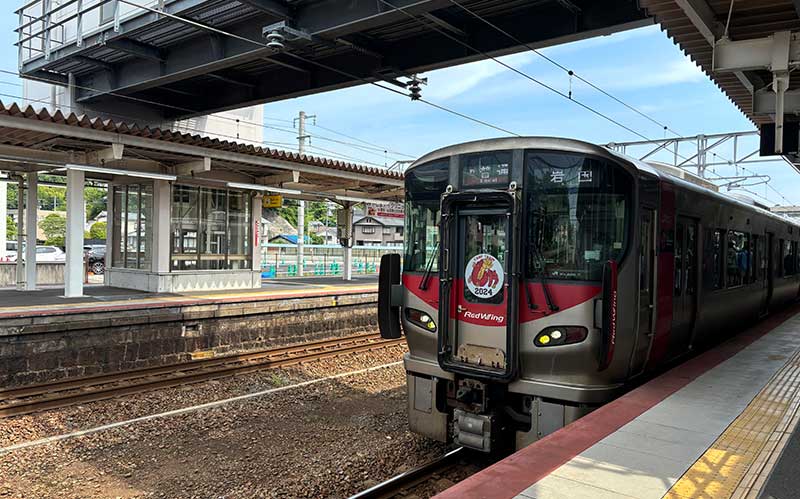
Miyajima-guchi Station, the starting point of Miyajima sightseeing
After exiting the Miyajima-guchi Station ticket gates, the Miyajima Pier is straight ahead on the road that stretches in front of the station. Once downstairs, cross the intersection by the underground passage and walk about 5 minutes to the pier. After crossing the intersection and going up to the ground level, you will find “Anagomeshi Ueno” on your right in the direction of travel.
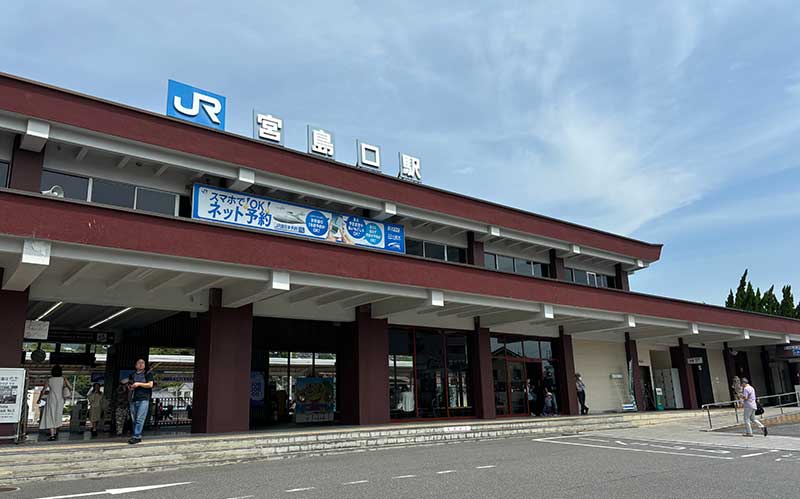
Anagomeshi Ue, a famous restaurant for its excellent anago-meshi (conger eel stew)
Anagomeshi Ueno, which has been in business for more than 110 years, is famous for its specialty, anagomeshi (conger eel rice), one of Hiroshima’s most famous dishes. Invented by Mr. Tinkichi Ueno I, this dish of seasoned rice cooked in a broth made from conger eel bones and roughage has been loved by many people. The “Anago-meshi” is made with selected conger eel and grilled in its fine fat. The rice is soaked in the broth, and the glutinous rice is characterized by its firm texture. Anago-meshi eaten inside the restaurant as well as bento boxes are also exquisite. The “anago no shiroyaki” (grilled conger eel) is a must-try when you visit the restaurant, where you can enjoy the natural elasticity and fatty flavor of the conger eel. This is a great restaurant to stop by when sightseeing in Miyajima.
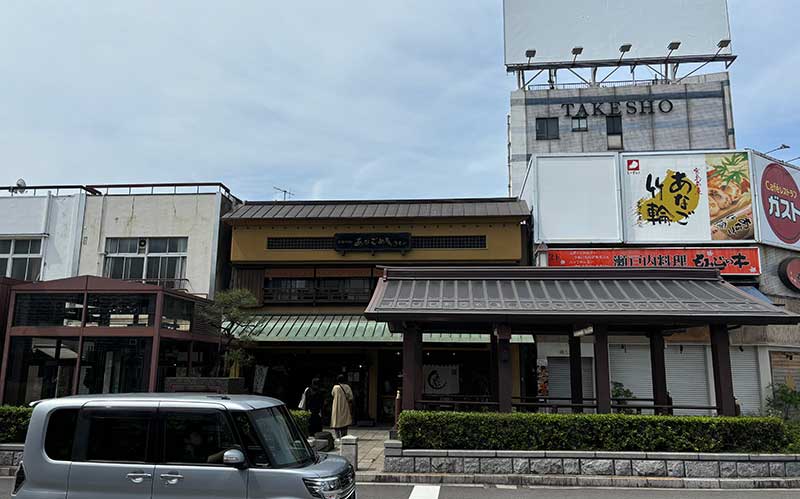
Anago meshi ueno
Address: 1-5-11 Miyajimaguchi, Hatsukaichi City, Hiroshima Prefecture
TEL:0829-56-0006
Official site:Click here
Board the Miyajima Ferry
Take a ferry from Miyajima-guchi Pier to Miyajima.
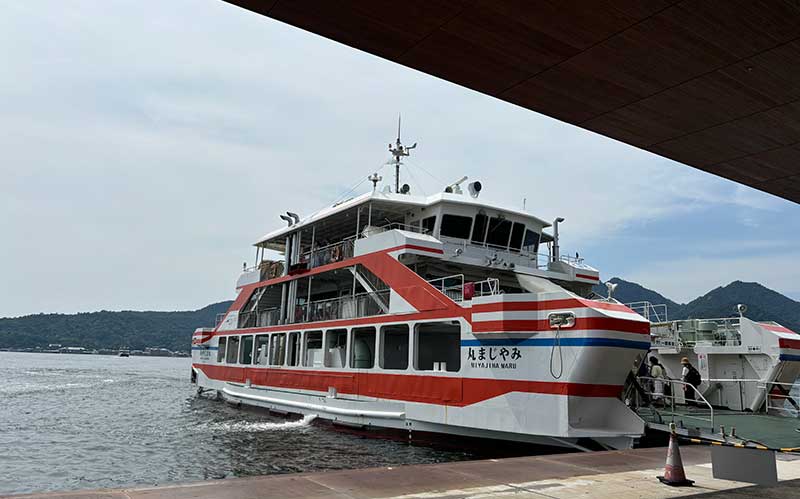
Two ferry companies, JR West Japan Ferry and Miyajima Matsudai Kisen, operate the ferry service, which runs approximately every 15 to 20 minutes.
The two companies operate different routes. JR West Miyajima Ferry operates the “Otorii Service,” which approaches the Otorii Gate on the 9:10 a.m. to 4:10 p.m. service from Miyajima-guchi. This is a great way to see the Otorii from the sea, and is recommended if the time is right.
During the 15 minutes it takes to arrive, you can enjoy the beautiful scenery while feeling the sea breeze.
The fare is 200 yen one-way for adults, 100 yen one-way for children, and 100 yen per visit tax, and transportation IC cards can be used, making it very convenient. Enjoy a comfortable ferry trip.
Ferry Official Site
JR West Miyajima Ferry official website:Click here
Miyajima Matsudai Kisen Official Website:Click here
Otorii Gate on the Seto Inland Sea
When crossing to Miyajima by JR ferry from Miyajima-guchi Pier, the Otorii (Grand Gate) of Itsukushima Shrine seen from the sea is a sight to behold. This vermilion-colored Otorii, towering above the sea, seems to float on the surface of the water. The torii is about 16 meters high, made of natural camphor wood, and stands on its own weight just by being placed in the sea.
In particular, the view from the ferry is an excellent spot for photography, and the Otorii, with its different expressions at different times of the day, is unforgettably beautiful once seen.
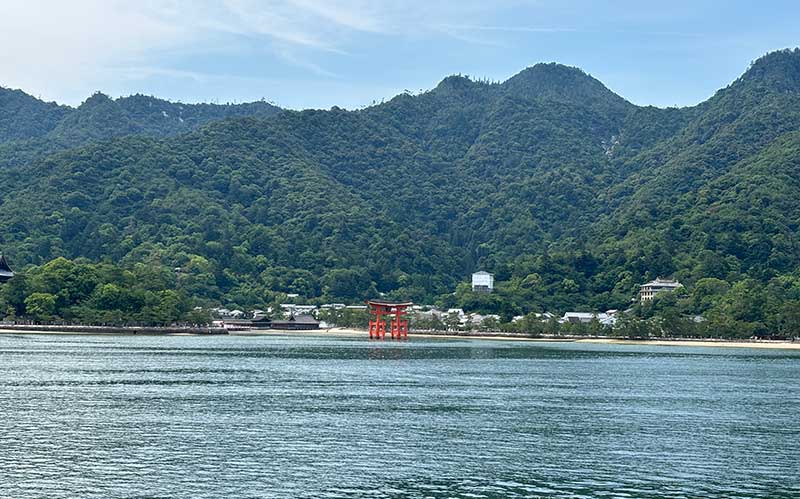
Tour of Miyajima starting from Miyajima Pier
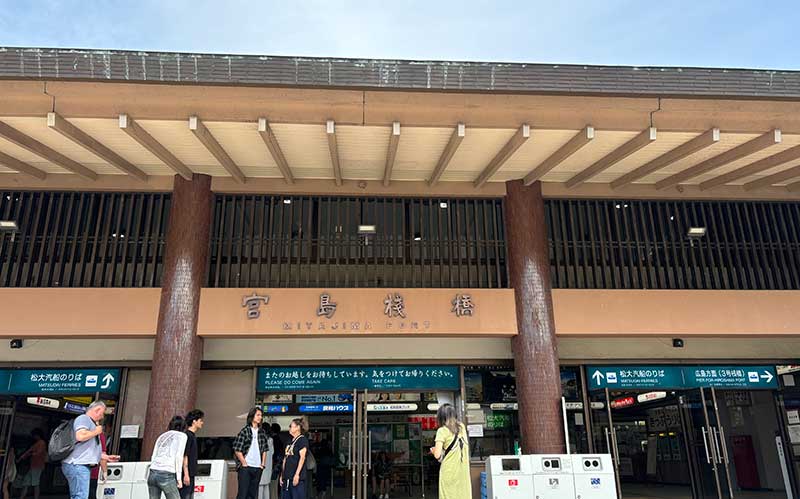
From here you will tour Miyajima on foot. There are no convenience stores on Miyajima. Prices are high on the island, so you may want to buy bottled tea or water at the station.
Mysterious Itsukushima Shrine, whose expression changes with the hour


Known as “Miyajima of Aki,” one of the three most scenic spots in Japan, Itsukushima Shrine was registered as a World Heritage site in 1996 and is recognized worldwide for its historical value and architectural beauty. The shrine was built in the 12th century by Taira no Kiyomori, and when the tide rises, the vermilion-lacquered pavilions appear to float on the sea, giving the shrine an enigmatic beauty. The shrine pavilions, connected by a corridor, create a graceful view at high tide, and the contrast with the greenery in the background further accentuates its beauty.

Pay the initial fee of 300 yen for adults and 200 yen for high school students, and enjoy the mystical view of the main shrine floating on the sea.
Itsukushima Jinja Shrine
Address: 1-1 Miyajima-cho, Hatsukaichi City, Hiroshima Prefecture
TEL:0829-44-2020
Official Site:Click here

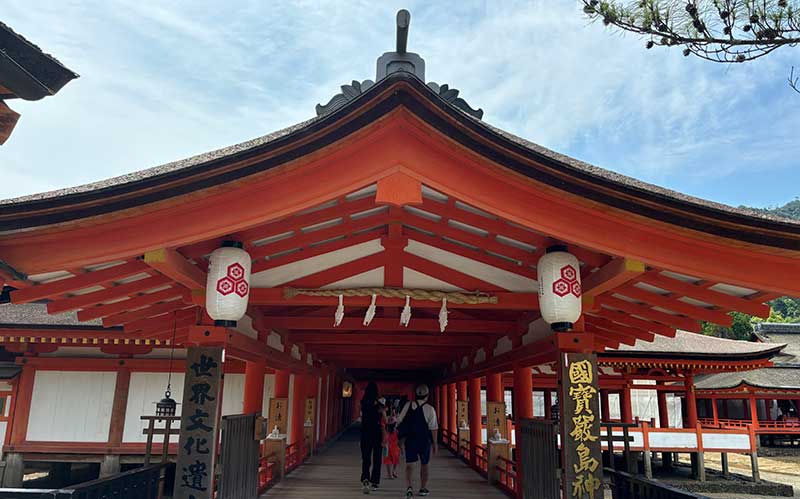

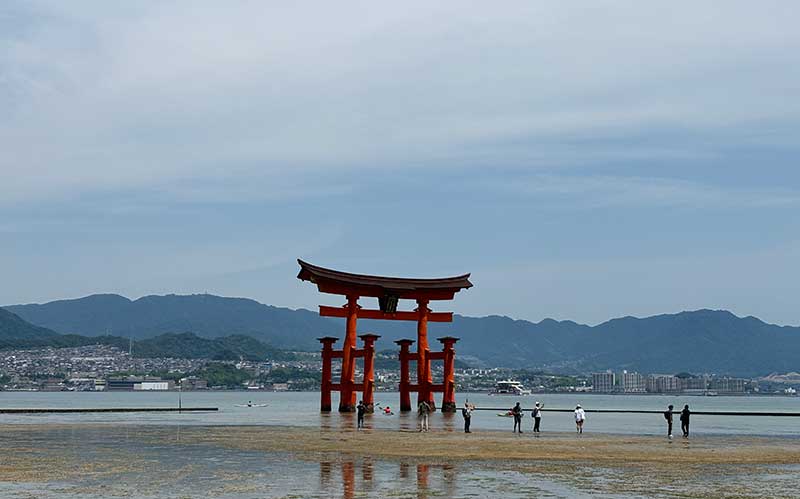
After enjoying Itsukushima Shrine, walk up the slope to Momijidani Park (about 10 minutes’ walk).
Leaving the bustling Itsukushima Shrine, we will continue to climb the mountain path.

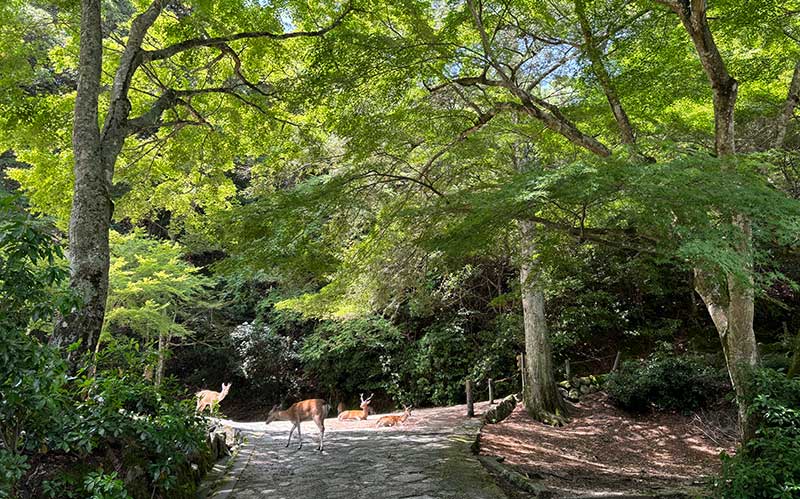
Along the way, deer can be seen relaxing and taking it easy.
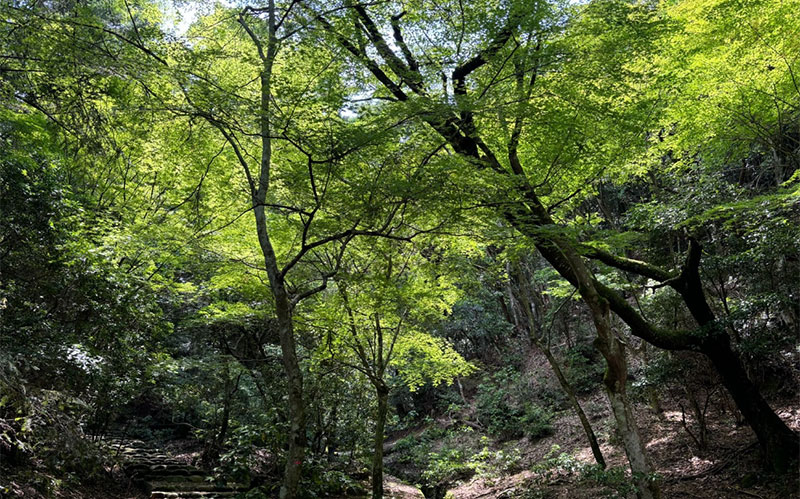
The green will deepen.
Healing in the Autumn Foliage Tunnel at Momijidani Park
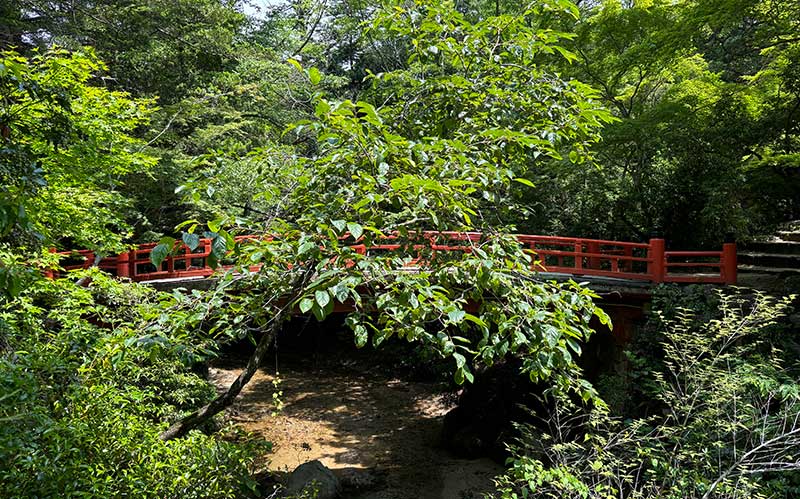
Momijidani Park is a rich natural spot with approximately 700 beautifully colored autumn leaves. In summer, the green trees create a cool shade, and in autumn, the brilliant colors of the autumn leaves attract visitors. The park is home to many gentle deer, which can be photographed relaxing. There is also a red bridge, a garden-style pond with carp, and a small waterfall. Enjoy a stroll and sometimes sit on a bench to relax and enjoy the changing nature of the seasons.
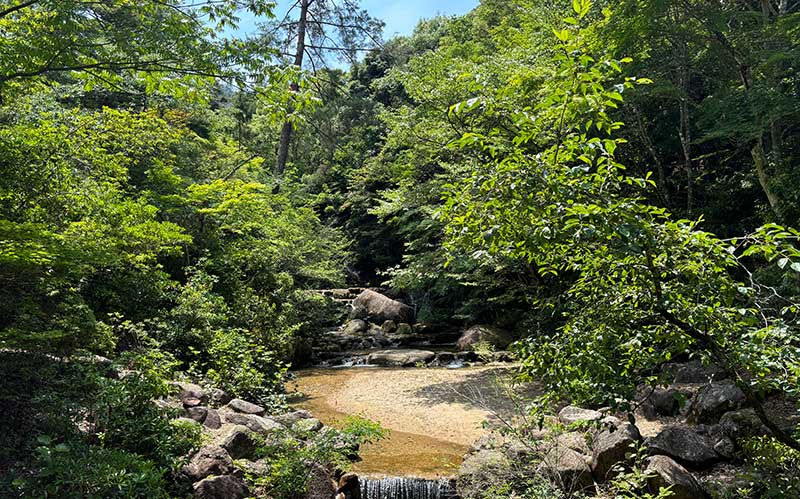
Since it is quite a walk, it is recommended to take a ropeway or a bus from the foot of the mountain.
Next, a 7-minute walk from Momijidani Park, we will go to Senjami-kaku, which was built by Hideyoshi Toyotomi.
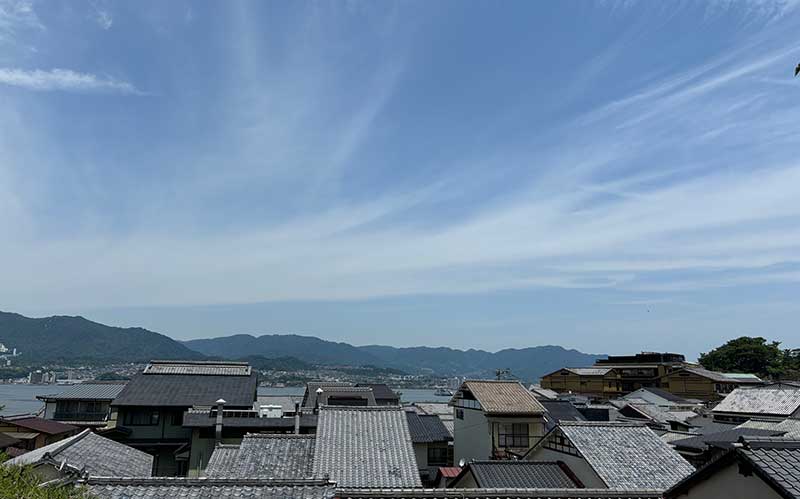
Standing in a vast space with a sense of history at Senjo-kaku

For a 100 yen entrance fee, you can take off your shoes and go up to the Sentamikaku, an area the size of 857 tatami mats.
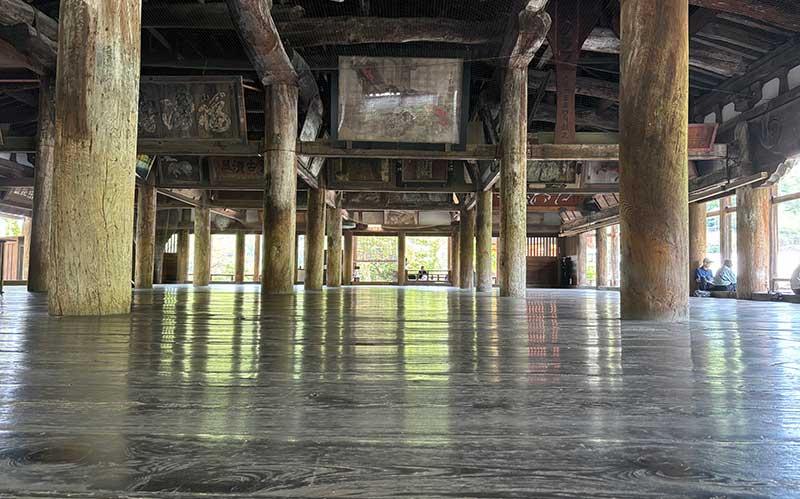
Senjokaku, as its name implies, is a vast wooden structure known as “Senjo-shiki,” officially called Toyokuni Shrine. Its construction was begun by Toyotomi Hideyoshi in 1587, but after his death, it has remained unfinished to this day. This unfinished state, on the contrary, enhances its unique charm.
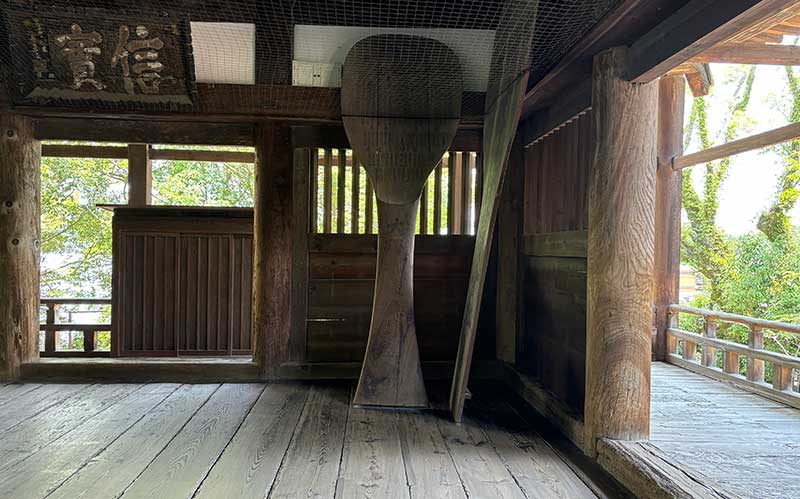
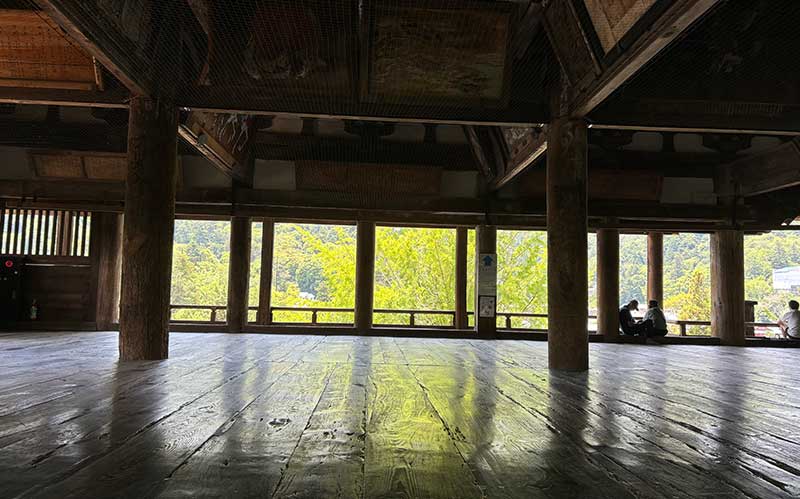
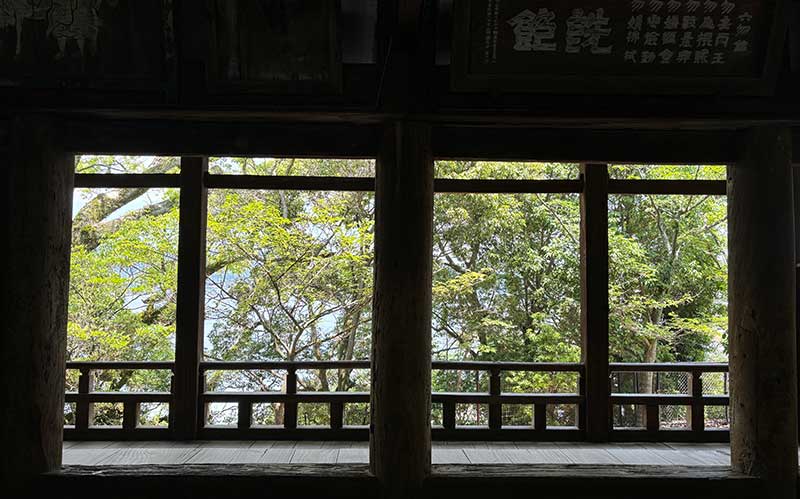
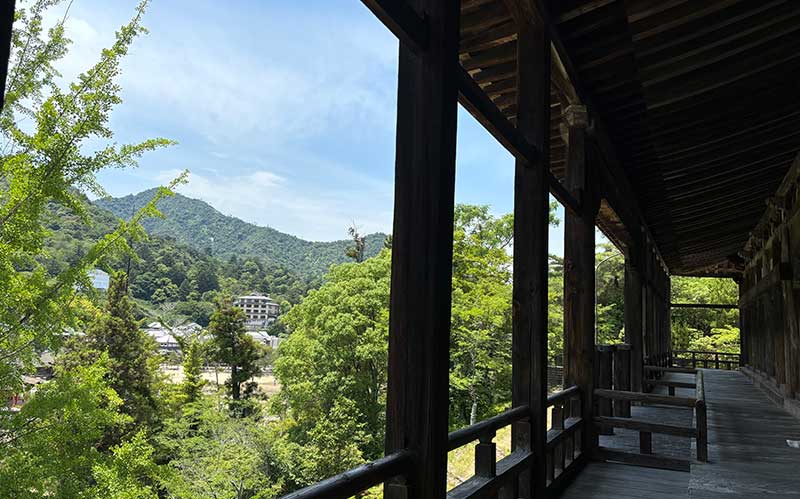
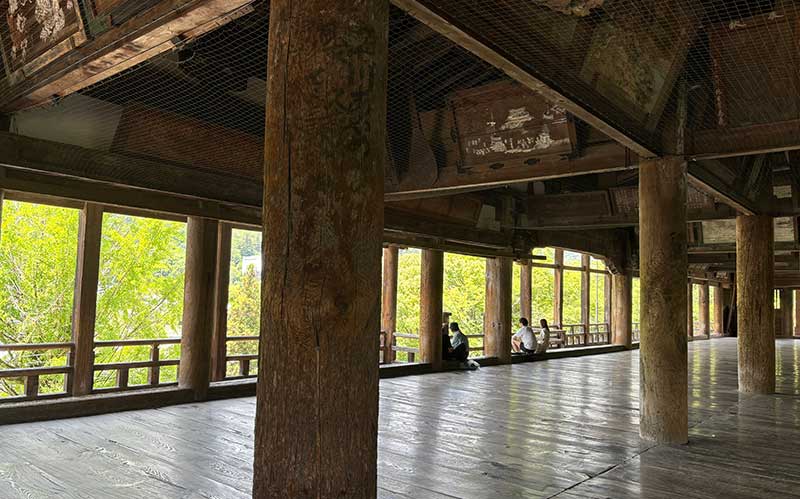
The interior of 857 tatami mats is spacious and shows a magnificent wooden structure with columns and beams. The entire building exudes the warmth of wood and is quiet and serene. Even during very busy times around Itsukushima Shrine, few tourists come this far, so you will be able to feel the weight of history in the silence.
From Senjo-kaku, visitors can also enjoy a spectacular view of Itsukushima Shrine and the Seto Inland Sea.
Sengokaku , Toyokuni Jinja Shrine
Itsukushima Jinja Shrine official website:Click here
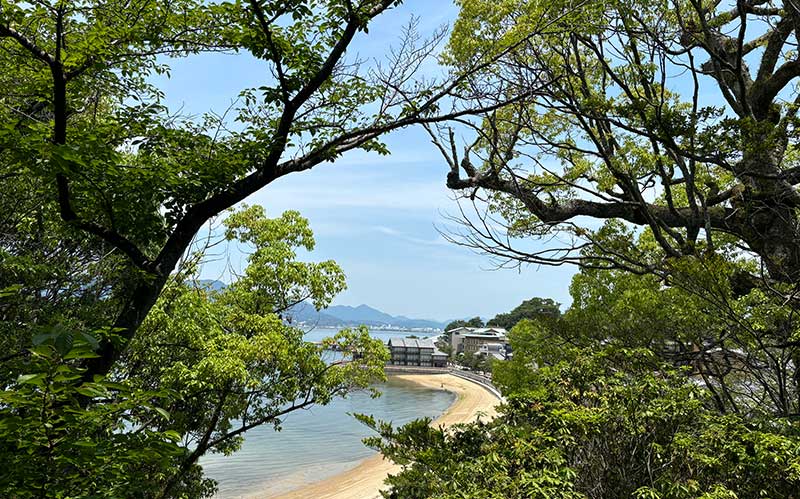
Next to Senjo-kaku is a five-story pagoda 29 meters high

Return to the pier through the shopping street
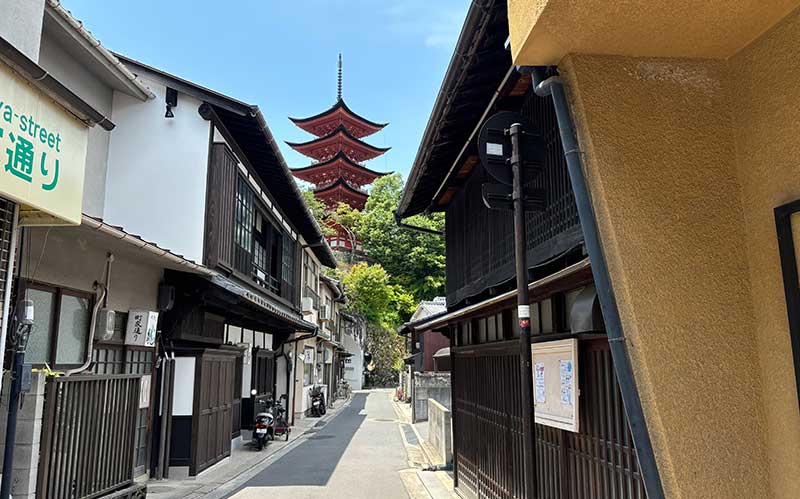
Enjoy local delicacies at Miyajima Omotesando Shopping Street
Miyajima Omotesando Shopping Street is a 350-meter shopping street leading from Miyajima Pier to Itsukushima Shrine. This shopping street is always crowded with people looking for souvenirs and enjoying gourmet food, including folk crafts such as Miyajima ladle, Miyajima gourmet foods using specialty products such as conger eel and oysters, cafes serving lemon-based drinks, and stores selling Hiroshima’s famous momiji manju buns.
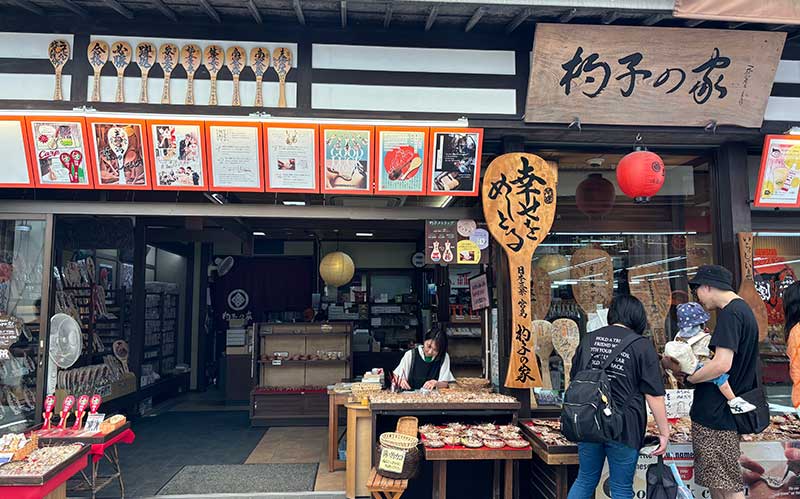
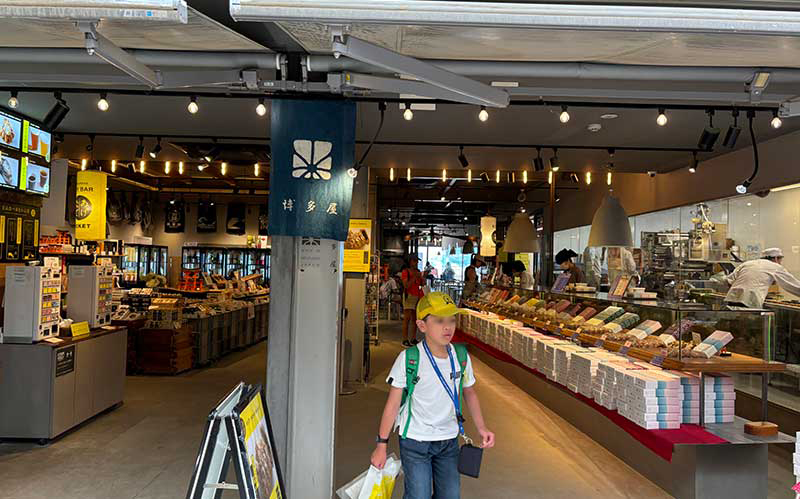
Located on the Itsukushima Shrine side of the Omotesando shopping street, “Hakataya” sells freshly fried momiji manju at its storefront. Tea is also prepared, so take a break while watching momiji-manju being made at the eat-in space in the back.
Hakata-ya
Hakataya Miyajima Itsukushima, founded in the Meiji era (official website):Click here

Return to the ferry pier through the shopping street and take the same route to Miyajima-guchi by ferry.

Riding the tram
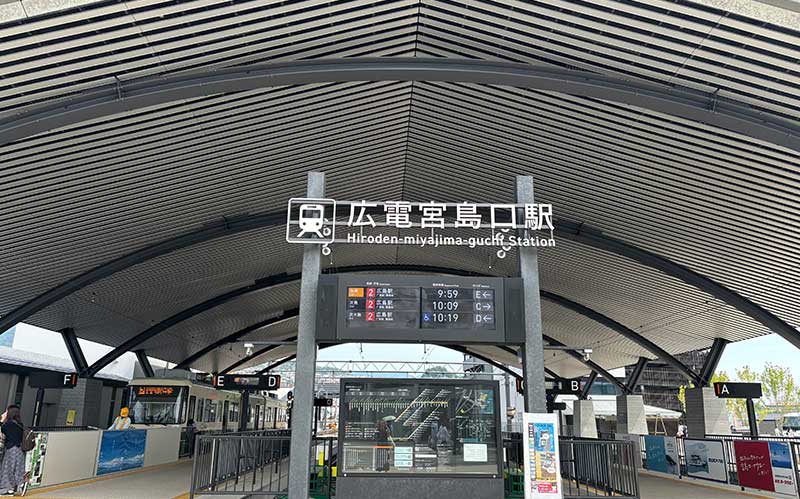
From the ferry terminal to Miyajima, take the Hiroshima Electric Railway to the Atomic Bomb Dome. The tram station is located immediately to the right of the ferry landing. From Hiroden Miyajima-guchi Station, it takes about 45 minutes to arrive in front of the Atomic Bomb Dome.
The fare to Miyajimaguchi Station is 250 yen, and you can also use a transportation IC card to get to the A-bomb Dome in 45 minutes.
Enjoy the city of Hiroshima at a leisurely pace.
Hiroshima Electric Railway Route Map
Official site:Click here

Get off the bus in front of the Atomic Bomb Dome, and the A-bomb Dome will appear right in front of you.
The World Heritage Site Atomic Bomb Dome reminds us of the tragedy of the atomic bombing.

The Atomic Bomb Dome was built in 1915 to the design of Czech architect Jan Retzl. The building was originally used as the Hiroshima Prefectural Industrial Promotion Hall, but was destroyed by the first atomic bomb in human history on August 6, 1945, and was completely destroyed by fire. However, the unique framework of the building remains, and is a valuable remnant that conveys the horrors of the atomic bombing to the present.
It has become a symbol of Hiroshima as a place that calls for the abolition of nuclear weapons and lasting peace, and was registered as a World Heritage site in 1996. On this day, many children visited the museum on school trips and social studies tours, and listened to the stories of the volunteers.
Peace Memorial Park, Peace Memorial Museum, and Orizuru Tower are located in the same park as the A-bomb Dome.
Stroll through Peace Memorial Park and renew your wish for peace
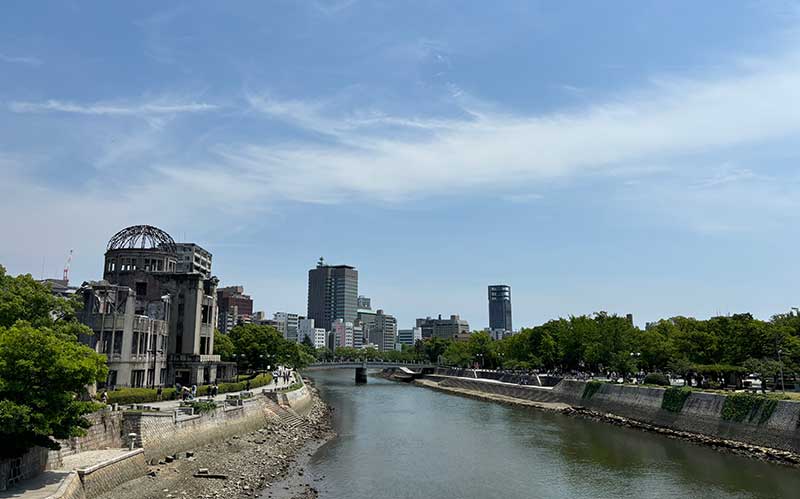
Located on the site where the atomic bomb was dropped during World War II, the park is visited by peace-loving people from all over the world. The park was established in 1949 and exists as a symbol to remember the horrors of war and to pledge the abolition of nuclear weapons and lasting peace.
The park is dotted with many memorial facilities, including the Atomic Bomb Dome, the Peace Bell, the Peace Lamp, and the Cenotaph for the Atomic Bomb Victims, which strongly emphasize to visitors the tragedy of war and the importance of peace. The Peace Memorial Ceremony, held every year on August 6, attracts a large number of people to mourn the victims and renew their pledge for peace.
Peace Bell
The “Peace Bell” is a symbolic monument that calls for the abolition of nuclear weapons and world peace. The bell was installed in 1954 and visitors are free to ring it. The sound of the bell ringing echoes throughout the park, renewing prayers and pledges for peace. The bell is inscribed with the words “Abolish Nuclear Weapons with Wisdom,” and its resounding echoes send a message of peace to the world.
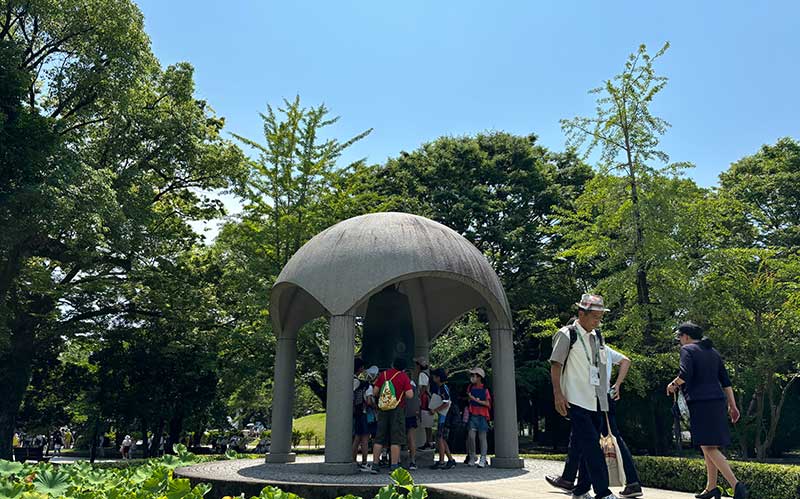
Cenotaph for the Atomic Bomb Victims
The Cenotaph for the Atomic Bomb Victims was built in memory of all the victims of the atomic bombing on August 6, 1945. Inscribed in the center of the monument is the words, “Rest in peace, for we will not repeat our mistakes,” a pledge to the future. This cenotaph symbolizes the tragedy of war and the importance of peace, and serves as the centerpiece of the Peace Memorial Ceremony held every year on August 6, where many people offer their prayers.
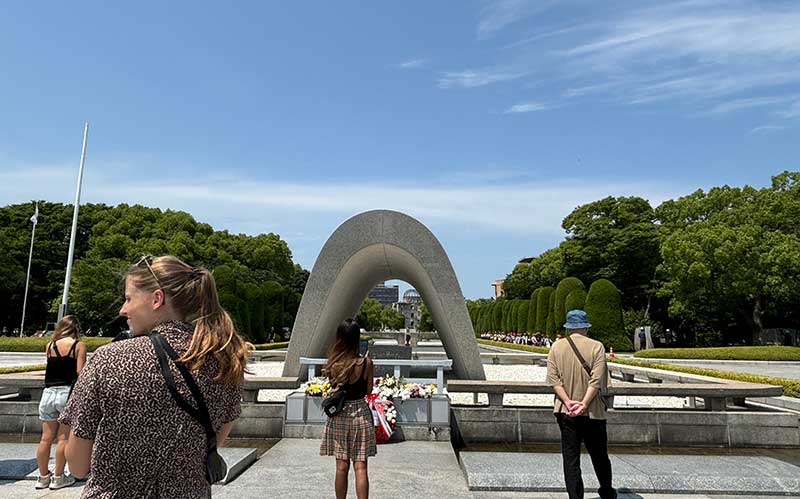
Thinking about the tragedies of the past and peace for the future at the Peace Memorial Museum
The Peace Memorial Museum exhibits the actual damage caused by the atomic bombing and the history of Hiroshima before and after the bombing. The museum was established as a place to strongly appeal for the abolition of nuclear weapons and the realization of lasting world peace. The museum exhibits artifacts and photographs of A-bomb survivors, as well as video recordings, to deeply appeal to visitors about the tragedy of war and the importance of peace.
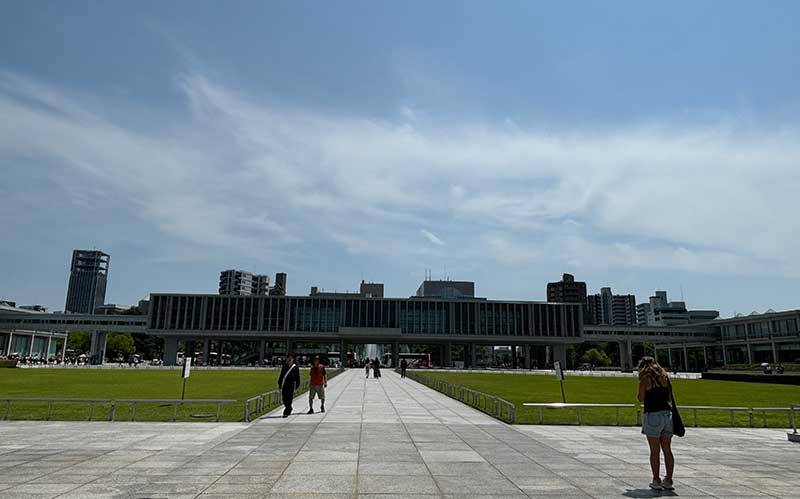


Hiroshima Peace Memorial Museum
Address: 1-2 Nakajimacho, Naka-ku, Hiroshima City, Hiroshima Prefecture
TEL:082-241-4004(General Information)
Official Site:Click here
Leave Peace Memorial Museum and return to the park along the river toward the Atomic Bomb Dome.
Just in front of the park is the Orizuru Tower.
Enjoy the spectacular view at Hiroshima’s new landmark, Orizuru Tower
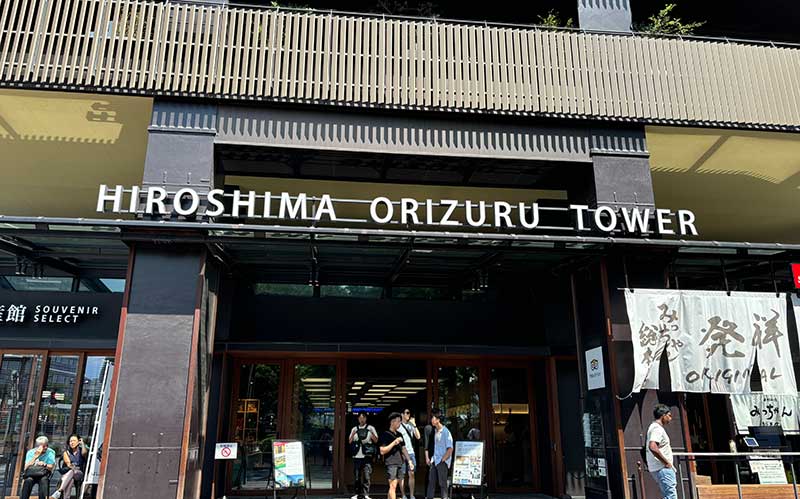
Orizuru Tower
Address: 1-2-1 Otemachi, Naka-ku, Hiroshima City, Hiroshima Prefecture
TEL:082-569-6803
Official Site:Click here
Orizuru Tower is a facility that opened in September 2016; on the first floor there is a store selling Hiroshima products. Visitors can take the elevator up to the observation deck, where they can enjoy a spectacular view of the Atomic Bomb Dome, Peace Memorial Park, and on a clear day, Mt. Visitors can also make their own wishes for peace by folding origami paper and attaching them to the tower’s symbolic “Wall of Origami Orisuru.
Take a short walk behind the Orizuru Tower and walk down the main street a little toward Hiroshima Station.
From Ebisucho Station to Hiroshima Station
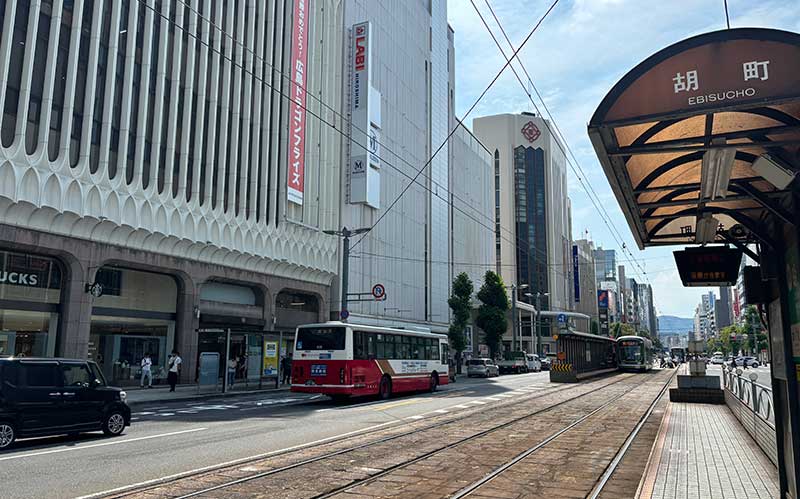
Return to Hiroshima Station.
Take a streetcar from in front of the Atomic Bomb Dome to Hiroshima Station [Hiroshima Electric Railway].
The tram takes 19 minutes, costs 220 yen, and runs about every 10 minutes.
Hiroshima Station
Today’s stroll is over.Thank you for your hard work!
Hiroshima Stroll |A review of the classic Hiroshima course for the first time visiting two World Heritage sites.
A.(Start)Hiroshima Station (jR Sanyo Main Line)
↓ 25 min.
B.Miyajima-guchi Station
↓ 5min.
C.Miyajima-guchi (ferry)
↓ 15min.
D.Miyajima
↓ 350m
E.Miyajima-guchi (Hiroden)
↓ 45min.
F.Atomic Bomb Dome
↓ 5min.
G.Peace Memorial Park
↓ 5min.
H.Orizuru Tower
↓ 20min.
I.Hiroshima Station
Access to JR Hiroshima Station
Access by Airplane
Limousine Bus from Hiroshima Airport: A limousine bus runs from Hiroshima Airport to JR Hiroshima Station, which takes approximately 45 minutes.
Buses run several times an hour for your convenience.
From Hiroshima Airport by Taxi:
A taxi will take you from Hiroshima Airport to JR Hiroshima Station in about 45 minutes, but the fare is more expensive than the limousine bus.
Access by car
Using the Sanyo Expressway: Exit at the Hiroshima Higashi IC or Hiroshima IC of the Sanyo Expressway and follow Route 54 to Hiroshima City. Follow the directions for Hiroshima City toward JR Hiroshima Station.
Parking Information: There are several parking lots around JR Hiroshima Station, but it is convenient to use the parking lots in the station building or coin-operated parking lots in the area.
Parking at the JR Hiroshima Station Shinkansen Exit is 200 yen for 30 minutes.
Access by train
Shinkansen: The Tokaido and Sanyo Shinkansen lines provide direct access to JR Hiroshima Station from major cities such as Tokyo, Osaka, and Fukuoka. It takes approximately 4 hours from Tokyo, 1 hour and 30 minutes from Osaka, and 1 hour from Fukuoka.
Conventional Lines: Conventional lines such as the Sanyo Main Line, Kure Line, and Kabe Line serve JR Hiroshima Station. Access from various cities in Hiroshima Prefecture is also convenient.
City Tram (Hiroshima Electric Railway): City Trams run from major spots in Hiroshima City to JR Hiroshima Station, providing very convenient access. Get off at the Hiroshima Station stop and you will soon arrive at JR Hiroshima Station.
